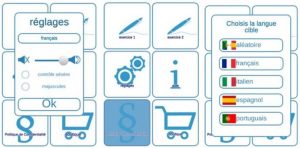How to use the app
The structure of the app consists of six boxes presenting the equivalences of the four romance target languages as well as English and German. The boxes of the language(s) you have chosen (= target language[s]) are left blank. One or two initial letters will help you find the word you are looking for.

The only function of the equivalents is (a) to elicit your associations between the languages you already know and the target word you intend to learn and (b) to help you find the right form and meaning.
How do I use the app?
Choose the language of the app and the display. All languages or a special target language?

- Choose the language you want to learn. Here: Italian.
- Choose the type of exercise you want to perform: Option 1: only one target language. Option 2: several alternating Romance languages (plurilingualism).
- Fill in the blanks (option 1) or visualize the word you are looking for by clicking on the blank.
- Compare the target word with its equivalents. What are the similarities in form? … meaning? What are the differences? Are there any features/peculiarities? Is there the risk of false friends? What do you know about the bridge word(s) and the target word. Attention: The kind of comparing (cognitive) patterns – words, forms, functions, grammar, etc. – is essential for the effectiveness of learning (see also 6)!
- Note the forms “corrected” by the app. The app will ask you again for the right word. Be careful, do not consider the “corrected” form as a “mistake” or an “error”. This is most likely just a form that the app didn’t expect. But take advantage of the “correction” since it is a learning opportunity. Of course, this option exists only when you choose option 1. Write down a target word when you think you don’t really know it yet. Consult an electronic or paper dictionary to find out the meanings and other characteristics of the words concerned.
- To learn even more efficiently, use a notebook to construct the grammar of hypotheses. (You are somewhat in the role of the first Christian missionaries in sixteenth-century Japan who had to “detect” the Japanese language and build its grammar and vocabulary to be able to assume their task.) As for the effectiveness of the exercise, these activities are decisive. (Continue with How to operate…)